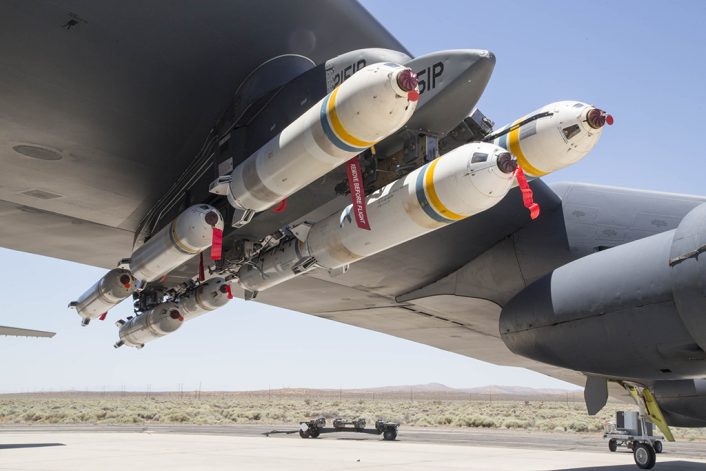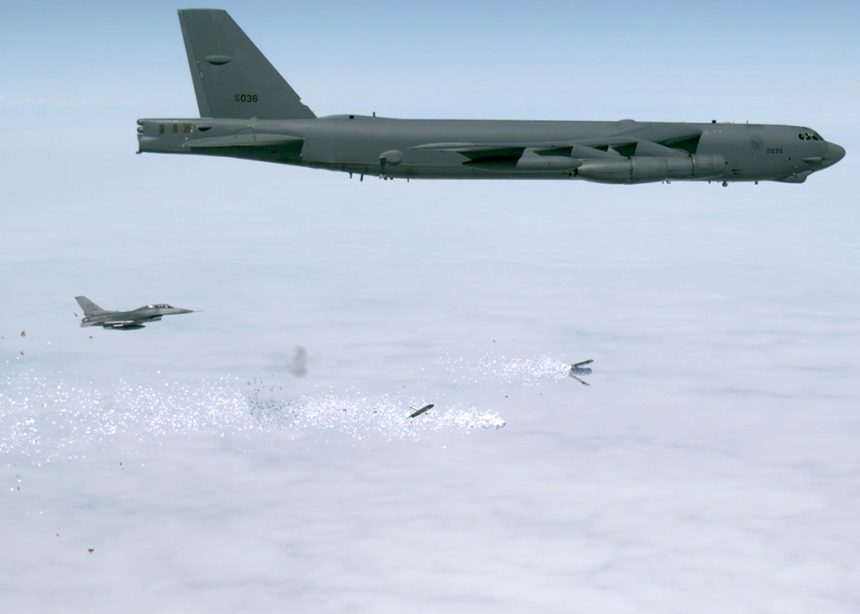Testers from the 419th Flight Test Squadron are looking to see if B-52 Stratofortress bombers can undertake psychological operations dropping leaflets with messages.
Along with nuclear bombs and several other weapons, the U.S. Air Force B-52 Stratofortress strategic bombers may one day be used to drop leaflets.
Indeed, the Air Force has recently completed two successful sorties, where testers from the 419th Flight Test Squadron, from Edwards Air Force Base, California, released eight PDU-5/B leaflet bombs over the Point Mugu Sea Test Range and eight more over the Precision Impact Range Area on Edwards.
“We are primarily looking to see safe separation from the external Heavy Stores Adapter Beam,” said Kevin Thorn, 419th FLTS B-52 air vehicle manager in a USAF public release. “We are ensuring that the bombs do not contact the aircraft, and/or each other, creating an unsafe condition. Additionally we are tracking the reliability of the bomb functioning.”
Leaflets with messages used to communicate with the locals or with the enemy troops (persuading them to surrender) have been part of the PSYOPS for decades. Such leaflets can be distributed in several different ways, including drops from a vast variety of aircraft, in order to reach a wide area.
For instance, in 2015, U.S. F-15E Strike Eagles dropped leaflets over Islamic State insurgents in Syria using PDU-5B leaflet canisters; in 2012, air drop of leaflets in support of Information Operations were conducted by the U.S. Army above Helmand province, Afghanistan, using U.S. Marine Corps MV-22B Osprey tilt-rotor aircraft in areas of the Helmand province unreachable by conventional communication. During the Air War in Libya, in 2011, U.S. Air Force EC-130s broadcast radio messages to the Libyan military to persuade them to return to their families before it was too late, whereas Italian C-130J aircraft dropped leaflets over Tripoli to counter Gaddafi’s regime propaganda in Libya’s capital city.
Leaflets have been also air dropped by Syrian Arab Air Force Mil Mi-8 helicopters over Aleppo in August 2012 to urge rebels to surrender to the Syrian Army and even Israeli A-4 dropped leaflets over the northern Gaza Strip in November 2012, to call for civilians to stay away from terrorist target areas and emphasize that Hamas was responsible for the situation in the Strip.
Today, testers from the 419th Flight Test Squadron are looking to see if the world’s most iconic strategic bomber can accomplish this task.
The B-52 used a PDU-5/B, a new-use or variant of an older Cluster Bomb Uni designated MK 20 Rockeye II, SUU-76B/B, and/or CBU-99/100 depending on the type of filler used in the bomb.
The PDU-5/B (the same used by the F-15E mentioned above), can deliver about 60,000 leaflets; it was first deployed in Operation Iraqi Freedom before any Air Force munitions began hitting targets in Baghdad, Iraq.
“Without the capability to carry PDU-5s on the B-52 aircraft, the impending shortfall on leaflet dispersal capability will jeopardize Air Force Central Command information operations,” said Earl Johnson, B-52 PDU-5/B project manager. The “Buff” can carry 16 PDU-5s under the wings, making it able to distribute 900,000 leaflets in a single sortie.
The testing the PDU-5/B on the B-52 is complete for now even though the program is forecasted to return at a future date to test PDU-5/B releases from the B-52’s internal weapons bay.










